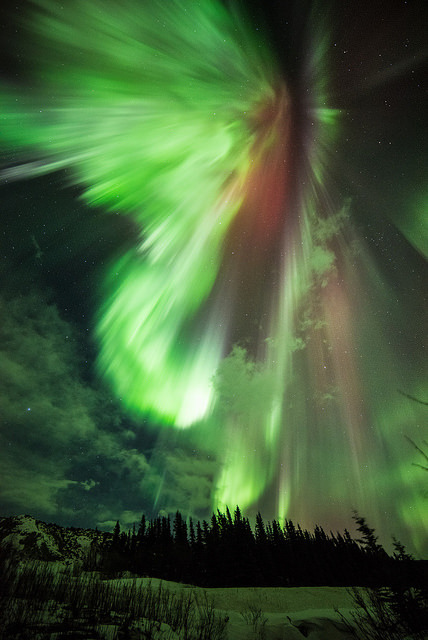Incoming! We’ve Got Science From Jupiter!
Incoming! We’ve Got Science from Jupiter!
Our Juno spacecraft has just released some exciting new science from its first close flyby of Jupiter!

In case you don’t know, the Juno spacecraft entered orbit around the gas giant on July 4, 2016…about a year ago. Since then, it has been collecting data and images from this unique vantage point.

Juno is in a polar orbit around Jupiter, which means that the majority of each orbit is spent well away from the gas giant. But once every 53 days its trajectory approaches Jupiter from above its north pole, where it begins a close two-hour transit flying north to south with its eight science instruments collecting data and its JunoCam camera snapping pictures.

Space Fact: The download of six megabytes of data collected during the two-hour transit can take one-and-a-half days!

Juno and her cloud-piercing science instruments are helping us get a better understanding of the processes happening on Jupiter. These new results portray the planet as a complex, gigantic, turbulent world that we still need to study and unravel its mysteries.
So what did this first science flyby tell us? Let’s break it down…
1. Tumultuous Cyclones

Juno’s imager, JunoCam, has showed us that both of Jupiter’s poles are covered in tumultuous cyclones and anticyclone storms, densely clustered and rubbing together. Some of these storms as large as Earth!

These storms are still puzzling. We’re still not exactly sure how they formed or how they interact with each other. Future close flybys will help us better understand these mysterious cyclones.

Seen above, waves of clouds (at 37.8 degrees latitude) dominate this three-dimensional Jovian cloudscape. JunoCam obtained this enhanced-color picture on May 19, 2017, at 5:50 UTC from an altitude of 5,500 miles (8,900 kilometers). Details as small as 4 miles (6 kilometers) across can be identified in this image.

An even closer view of the same image shows small bright high clouds that are about 16 miles (25 kilometers) across and in some areas appear to form “squall lines” (a narrow band of high winds and storms associated with a cold front). On Jupiter, clouds this high are almost certainly comprised of water and/or ammonia ice.
2. Jupiter’s Atmosphere
Juno’s Microwave Radiometer is an instrument that samples the thermal microwave radiation from Jupiter’s atmosphere from the tops of the ammonia clouds to deep within its atmosphere.

Data from this instrument suggest that the ammonia is quite variable and continues to increase as far down as we can see with MWR, which is a few hundred kilometers. In the cut-out image below, orange signifies high ammonia abundance and blue signifies low ammonia abundance. Jupiter appears to have a band around its equator high in ammonia abundance, with a column shown in orange.

Why does this ammonia matter? Well, ammonia is a good tracer of other relatively rare gases and fluids in the atmosphere…like water. Understanding the relative abundances of these materials helps us have a better idea of how and when Jupiter formed in the early solar system.
This instrument has also given us more information about Jupiter’s iconic belts and zones. Data suggest that the belt near Jupiter’s equator penetrates all the way down, while the belts and zones at other latitudes seem to evolve to other structures.
3. Stronger-Than-Expected Magnetic Field

Prior to Juno, it was known that Jupiter had the most intense magnetic field in the solar system…but measurements from Juno’s magnetometer investigation (MAG) indicate that the gas giant’s magnetic field is even stronger than models expected, and more irregular in shape.

At 7.766 Gauss, it is about 10 times stronger than the strongest magnetic field found on Earth! What is Gauss? Magnetic field strengths are measured in units called Gauss or Teslas. A magnetic field with a strength of 10,000 Gauss also has a strength of 1 Tesla.

Juno is giving us a unique view of the magnetic field close to Jupiter that we’ve never had before. For example, data from the spacecraft (displayed in the graphic above) suggests that the planet’s magnetic field is “lumpy”, meaning its stronger in some places and weaker in others. This uneven distribution suggests that the field might be generated by dynamo action (where the motion of electrically conducting fluid creates a self-sustaining magnetic field) closer to the surface, above the layer of metallic hydrogen. Juno’s orbital track is illustrated with the black curve.
4. Sounds of Jupiter
Juno also observed plasma wave signals from Jupiter’s ionosphere. This movie shows results from Juno’s radio wave detector that were recorded while it passed close to Jupiter. Waves in the plasma (the charged gas) in the upper atmosphere of Jupiter have different frequencies that depend on the types of ions present, and their densities.
Mapping out these ions in the jovian system helps us understand how the upper atmosphere works including the aurora. Beyond the visual representation of the data, the data have been made into sounds where the frequencies and playback speed have been shifted to be audible to human ears.
5. Jovian “Southern Lights”

The complexity and richness of Jupiter’s “southern lights” (also known as auroras) are on display in this animation of false-color maps from our Juno spacecraft. Auroras result when energetic electrons from the magnetosphere crash into the molecular hydrogen in the Jovian upper atmosphere. The data for this animation were obtained by Juno’s Ultraviolet Spectrograph.

During Juno’s next flyby on July 11, the spacecraft will fly directly over one of the most iconic features in the entire solar system – one that every school kid knows – Jupiter’s Great Red Spot! If anybody is going to get to the bottom of what is going on below those mammoth swirling crimson cloud tops, it’s Juno.

Stay updated on all things Juno and Jupiter by following along on social media: Twitter | Facebook | YouTube | Tumblr
Learn more about the Juno spacecraft and its mission at Jupiter HERE.
More Posts from Karlfelersii and Others
Why You Think You Are Not Good Enough AND How to Fix it

“If I asked you to name all the things you love, how long would it take to name yourself.” – Anon
There is no shortage of reasons why we sometimes feel like we flat out aren’t good enough. Maybe it’s low grades in school, or we think we are too thin, or too fat, or too young. Maybe our partner makes us feel inadequate, or our parents seem to believe we can’t do anything right.
Sometimes we do it to ourselves. We compare our home, or clothes, or cars to where someone else lives, or to what they wear, or to what they drive. If we believe their things are better than ours, then we tell ourselves we are less of a person.
Society doesn’t help us believe that we are unique, or that being unique is seriously “good enough.” There is constant pressure to be the best team, the best student, the best assistant, the best employee. We compare ourselves to models in magazines and hold ourselves to a certain standard of perfection that is as unrealistic as it is attainable.
It isn’t a Feeling. It’s a Thought.
When you don’t feel “good enough” it’s often because you are telling yourself you’re stupid, or ugly, or incapable. The thoughts you use to describe yourself make you unhappy. These thoughts make you feel depressed and worthless. According to Ali Miller, MFT, this is an important distinction. She believes that…
CONTINUE READING HERE







Source: http://creativesomething.net/post/54997033332/why-youre-more-creative-at-night-and-how-to






✧ Visit our website: psych2go.net ✧
Ψ Follow @psych2go for more Ψ

Follow us @anxietyproblem

Happy 4th of July… From Space!
In Hollywood blockbusters, explosions and eruptions are often among the stars of the show. In space, explosions, eruptions and twinkling of actual stars are a focus for scientists who hope to better understand their births, lives, deaths and how they interact with their surroundings. Spend some of your Fourth of July taking a look at these celestial phenomenon:

Credit: NASA/Chandra X-ray Observatory
An Astral Exhibition
This object became a sensation in the astronomical community when a team of researchers pointed at it with our Chandra X-ray Observatory telescope in 1901, noting that it suddenly appeared as one of the brightest stars in the sky for a few days, before gradually fading away in brightness. Today, astronomers cite it as an example of a “classical nova,” an outburst produced by a thermonuclear explosion on the surface of a white dwarf star, the dense remnant of a Sun-like star.

Credit: NASA/Hubble Space Telescope
A Twinkling Tapestry
The brilliant tapestry of young stars flaring to life resemble a glittering fireworks display. The sparkling centerpiece is a giant cluster of about 3,000 stars called Westerlund 2, named for Swedish astronomer Bengt Westerlund who discovered the grouping in the 1960s. The cluster resides in a raucous stellar breeding ground located 20,000 light-years away from Earth in the constellation Carina.

Credit: NASA/THEMIS/Sebastian Saarloos
An Illuminating Aurora
Sometimes during solar magnetic events, solar explosions hurl clouds of magnetized particles into space. Traveling more than a million miles per hour, these coronal mass ejections, or CMEs, made up of hot material called plasma take up to three days to reach Earth. Spacecraft and satellites in the path of CMEs can experience glitches as these plasma clouds pass by. In near-Earth space, magnetic reconnection incites explosions of energy driving charged solar particles to collide with atoms in Earth’s upper atmosphere. We see these collisions near Earth’s polar regions as the aurora. Three spacecraft from our Time History of Events and Macroscale Interactions during Substorms (THEMIS) mission, observed these outbursts known as substorms.

Credit: NASA/Hubble Space Telescope//ESA/STScI
A Shining Supermassive Merger
Every galaxy has a black hole at its center. Usually they are quiet, without gas accretions, like the one in our Milky Way. But if a star creeps too close to the black hole, the gravitational tides can rip away the star’s gaseous matter. Like water spinning around a drain, the gas swirls into a disk around the black hole at such speeds that it heats to millions of degrees. As an inner ring of gas spins into the black hole, gas particles shoot outward from the black hole’s polar regions. Like bullets shot from a rifle, they zoom through the jets at velocities close to the speed of light. Astronomers using our Hubble Space Telescope observed correlations between supermassive black holes and an event similar to tidal disruption, pictured above in the Centaurus A galaxy.

Credit: NASA/Hubble Space Telescope/ESA
A Stellar Explosion
Supernovae can occur one of two ways. The first occurs when a white dwarf—the remains of a dead star—passes so close to a living star that its matter leaks into the white dwarf. This causes a catastrophic explosion. However most people understand supernovae as the death of a massive star. When the star runs out of fuel toward the end of its life, the gravity at its heart sucks the surrounding mass into its center. At the turn of the 19th century, the binary star system Eta Carinae was faint and undistinguished. Our Hubble Telescope captured this image of Eta Carinae, binary star system. The larger of the two stars in the Eta Carinae system is a huge and unstable star that is nearing the end of its life, and the event that the 19th century astronomers observed was a stellar near-death experience. Scientists call these outbursts supernova impostor events, because they appear similar to supernovae but stop just short of destroying their star.

Credit: NASA/GSFC/SDO
An Eye-Catching Eruption
Extremely energetic objects permeate the universe. But close to home, the Sun produces its own dazzling lightshow, producing the largest explosions in our solar system and driving powerful solar storms.. When solar activity contorts and realigns the Sun’s magnetic fields, vast amounts of energy can be driven into space. This phenomenon can create a sudden flash of light—a solar flare.The above picture features a filament eruption on the Sun, accompanied by solar flares captured by our Solar Dynamics Observatory.
Make sure to follow us on Tumblr for your regular dose of space: http://nasa.tumblr.com
-
 leda-timeandspace liked this · 1 year ago
leda-timeandspace liked this · 1 year ago -
 traitorcas liked this · 1 year ago
traitorcas liked this · 1 year ago -
 chelseafcazul liked this · 1 year ago
chelseafcazul liked this · 1 year ago -
 k-riggy liked this · 1 year ago
k-riggy liked this · 1 year ago -
 mizar2 liked this · 2 years ago
mizar2 liked this · 2 years ago -
 sergioballester-blog liked this · 4 years ago
sergioballester-blog liked this · 4 years ago -
 tiredsnails liked this · 4 years ago
tiredsnails liked this · 4 years ago










